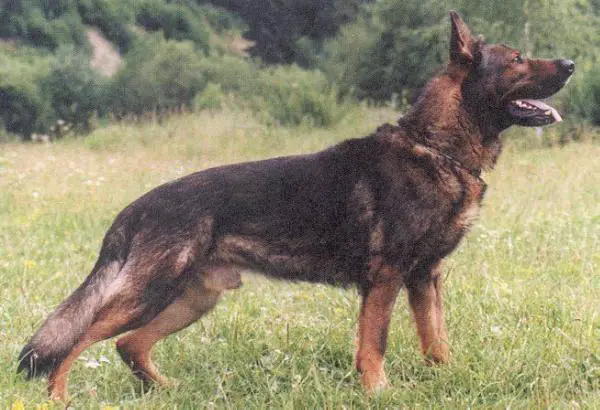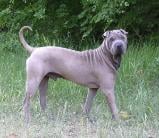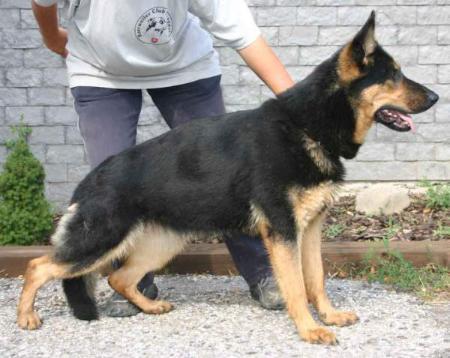
This is a placeholder text
Group text
by Nancy on 01 December 2007 - 12:12
So I am finishing my cup of coffee getting ready to go out in the cold and throw balls. Got to thinking.
Can you look at a sable and tell what the underlying other color gene is? Particularly if you don't know what the parents had?. FWIW that picture was taken when he was 3 but he has darkened up in the past year. Just curious since it is only color.
The only thing I know is that all progeny listed on the database of sire and dam (different breedings ) are sable so I guess it is a fairly good chance that the gene is doubled.
by pod on 01 December 2007 - 14:12
Interesting question. It was once thought that sable in the Rough Collie was partially dominant, and shaded sables were the heterozygotes Ayat (sable carrying tanpoint) but breeding data, and later DNA evidence proved this to be incorrect.
The usual type of sable in the GSD is the other type; wolf sable aw and there are some colour specialist who think this is also incompletely dominant over tanpoint and recessive black.... and I have saeen a fair bit of evidence in other breeds that supports this. In the Finnish Lapphund, a wolf sable that carries recessive black tends to have a much darker face. This is a breed that doesn't have the ususl mask of the Shepherd, so it's much easier to see.
The colour researcher Sheila Schmutz is currently working on the A locus. Ay sable has already been identified but the other alleles still remain unidentified. It could possibly be that they are all the same allele anyway.
by eichenluft on 01 December 2007 - 14:12
I would say it would be very difficult to know what the sable dog carries as a recessive, without knowing the colors of the parents/grandparents - unless the sable was extremely dark "black" sable - in which case he probably carries black recessive - also black pencil marks on toes (or lack of) are an indication of EITHER black or bicolor recessive being carried by the sable dog - no toe-marks means he either carries sable or black/tan, not black or bicolor. The only way to really tell for sure what the gene is that he carries as a recessive, is to breed him and see what he is capable of producing. Or, of course if one of his parents is black, then he definately carries black.
molly
by Nancy on 01 December 2007 - 15:12
Yes it is kind of interesting in a fun way. He does have strong penciling, tarheels, and the black down the front of the black legs. The inside of the ears is very darkly pigmented. So it sounds like he does carry something else. He is definetly not a "red sable" though I don't know how dark is dark to be considered a dark "black sable". He is darker than the picture.
by eichenluft on 01 December 2007 - 16:12
Lookign at the picture your dog is very dark, lots of black coverage plus the toe-marks and tarheels, I'm sure he carries a black recessive. In my experience sables with toe-marks and tarheels either carry black or bicolor recessive. Sables with no tarheels or toemarks, even if they are very dark themselves, either carry another sable or a black/tan recessive. The interesting thing is, with black/tan dogs - they do not have to have the toe marks/tar heels to indicate they carry black recessive. Have to breed them to find out, or of course know that one parent is black. Here is Cliff, a dog I had for a while - he is a very dark red sable, hard to tell in the picture but he has distinct toe marks and tar heels. I assumed he carried black, but he does not. He does carry bicolor recessive. http://www.pedigreedatabase.com/gsd/pedigree/117587.html
by darylehret on 01 December 2007 - 23:12
Quoting Molly: "The interesting thing is, with black/tan dogs - they do not have to have the toe marks/tar heels to indicate they carry black recessive."
Here's a black&tan gal that illustrates that point, that has a litter on the ground now, with two solid black pups. On the link below, you'll find no photos for obvious clues that she carried the black gene for at least four generations, perhaps more. By common definition, she's not a true bicolor, but if bred to a solid black, I wonder if she could produce true bicolor pups, (assuming the bicolor is a modifier gene.) Normally, a black&tan with a black recessive gene when bred to solid black would be expected to produce either black&tan, or black, and no bicolors.
www.pedigreedatabase.com/gsd/pedigree/481522.html
I'm pretty sure I've seen sable dogs with recessive black that didn't have tarheels or toemarks, but I don't think I can recall an example of a dog with tarheels or toemarks that didn't have recessive black gene. The only thing I can tell you with certainty, is that BOTH parents of Grim vd Woude were sable (long story), and as you can see from the pedigree of this gal above, the black trait can remain hidden for many generations.
by Nancy on 02 December 2007 - 03:12
Daryl, I sent you a PM
by darylehret on 02 December 2007 - 05:12
I'll answer the PM soon , but here's the reasoning on the Sable parentage;
Grim's sire, Aridon Snehulienka, also produced Eno zo Stiavnickych hor (half brother to your Grim). Eno is a sable dog from a black dam. That means the sable gene in Eno came from his sire (Aridon), because a black dog is always homogenous for black. Since his sire had a sable gene, he could only be a sable dog, no matter what recessive gene he may have.
On the dam side, Grim z Pohranicní stráe is a homogenous sable, he's not produced anything but sable pups. He'd been bred to black dogs also, so I can be pretty certain. Therefore, he could only contribute a sable gene to Poly, and since she has a sable gene, she could only be a sable dog, no matter what recessive gene she may have.
by darylehret on 02 December 2007 - 05:12
I guess I should add, that Grim z Pohranicní stráe is an example of a sable with tarheels, but no black recessive. So, as a false indicator for a black recessive, your boy could potentially be homogenous for sable.

Contact information Disclaimer Privacy Statement Copyright Information Terms of Service Cookie policy ↑ Back to top






